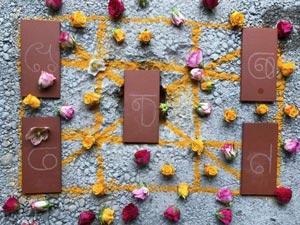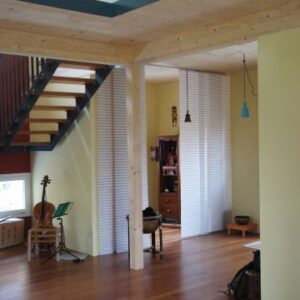Can external boundaries support inner growth? The answer is yes, but how?
With an orderly external boundary, as we create with Vāstu architecture, we create a harmonious form, an orientation which is supported by the energy lines of the earth, an open vibrant center, an auspicious measure that yields a pleasant rhythm and proportion on a visual and vibrational level, symmetry and an appealing design. Dr. V. Ganapati Sthapati would say:
“With Vāstu we bring heaven on earth”
The Concept of Resonance
Each structure in the universe is a resonant body. The underlying measure of the structure defines the frequency of the object itself. As previously stated, the aim of Vastu is to establish a resonance between the inhabitants, the built structure and nature.
How are we able to determine the frequency of the inhabitants? Vāstu considers the moonstar (in Sanskrit Nakshatra) of the person. According to Vedic astronomy and astrology, the ecliptic is divided into 27 major stars. At the time of a person’s birth, as seen from earth, the moon is placed in close relation to one of these 27 stars. This is then considered to be our moonstar, which is an indicator of our vibration throughout the course of our life. We then design the house using a Vāstu measure that is compatible with the vibration of all the inhabitants as indicated by their moonstars.

If we take this concept of resonance into consideration, we not only build beautiful and energetic structures; these structures will also resonate in a supportive way with their inhabitants. As such, the residents feel materially and spiritually enlivened, happy to return to their home, their personal oasis of well-being.
Illustrative of the theory of resonance, we quote here the experience of a family that recently moved into their Vāstu house:
“During the first two months we initially felt a pleasant buzzing sensation which later turned into a feeling of being really at home. Everyone settled down and we began to experience a lot of harmony within our family. At the same time, many positive things are happening on the level of consciousness.” ~ Vāstu Resident, Wangen a.d.A., Switzerland
Basic principles of Vāstu
The following points represent in no way a complete list of all the Vāstu aspects, but they are probably the most essential principles that are taken into account by an authentic Vāstu consultant or architect. Before such principles are applied, they should be fully understood.
1. The Plot

Once a suitable plot is chosen, we can respect the earth with special ceremonies before and during construction, and ask for blessings for our project.
2. Mathematic as Basis for the Perimeter
As a next step, we define the perimeter of the structure we intend to build on the plot. As we heard on the previous page, it is the perimeter – more specifically, the exact dimensions of the “empty” space that we enclose – which will define the frequency of the intended structure. We don’t just randomly choose a perimeter since this will also bring only arbitrary results. The resultant building should have a positive frequency, which will also be in resonance with the indwellers. To find an auspicious measure for the perimeter, Vāstu offers us a set of mathematical formulas. These formulas were kept secret by the Vāstu architects and masters (Sthapatis) for many millennia to make sure that this knowledge was not misused. A structure with such a perimeter – called the motherwall in Vāstu – will become a resonance body with qualities such as mental peace, happiness and material wellbeing. The vibration of the so created space will influence our psychology and our physical body. And it is well known that our thinking has an immense influence on our life.
3. Geometry
Vāstu considers a square (or rectangle) as the basic form of quantum space and therefore chooses to build the main body of any structure in either one of these two shapes. Actually, the basic form is nor a square, nor a rectangle, but a cube. So, with Vāstu we not only consider the horizontal plane dimensions but also the vertical. Within the frame of this cubical three-dimensional main body of the structure, carefully designed variations on the cuboidal form are welcome.
In keeping with creating a “resonant” perimeter, all other design elements such as interior walls, doors, windows, etc., are ideally also mathematically and geometrically calculated to the perimeter, the same vibration.
Vāstu structures (houses and offices) are designed along a 9×9 grid with 81 equal-sized modules, called Padas. Below is a drawing of this 9×9 grid. We can see how a human form is drawn sitting inside of it in a yogic position. This grid is known as Vāstu Purusha Mandala or the grid of the personified living space. The lines of this grid carry the energy of the motherwall into the space. By aligning walls, doors, etc. according to these lines they are nurtured with that same beneficial energy.
4. The Center

The center is the heart and intelligence of the space. The center should therefore be kept free, not blocked by walls or any other construction element. We know this open center also from ancient Roman architecture, called the atrium. This is the reason why the Mayan pyramids were kept free in the centre and why all the big temple complexes in and around India have their inner sanctum, the spiritual core in the center. The free open center can be covered by a roof. In a home, it can practically be included into the living room, the entrance area or the hall way that connects the different rooms around it.
5. Energy Lines
The center is the source of energy. This energy rises upwards as a result of this “gushing” forth in the form of a flame. This flame has a pyramidal form. Pyramid literally means “fire in the middle.” But since the energy does not move only vertically, but also horizontally, we try not to impede this flow of energy in any direction. Horizontally, we provide a space for the flow of two vibrant threads of light or energy, the Brahma-Sutra and Soma-Sutra. The Brahma-Sutra runs through the center of the grid, parallel to the main entrance and the Soma-Sutra perpendicular to the Brahma-Sutra (see illustration on the last page)
In addition, we consider one more thread of energy, the Yoni Line, which runs through the main entrance and therefore also parallel to the Brahma-Sutra. Also the Yoni line has to be kept completely free in order to guarantee the flow of energy through the structure. Opposite the main entrance there should also be a door or a window. In this way the structure will be alive and can breathe.
6. Building Orientation
The Earth is covered by a grid of subtle energies (on the North-South and East-West axis), nurtured by the enormous potential of the earth’s core. Many animals use that grid to orient themselves. We connect to and take advantage of those forces by aligning Vāstu structures to the cardinal directions. The wonderful effect is that we not only receive energy from Earth but can also return energy by building resonant objects (Vāstu structures), which are in tune with the subtle natural laws and this grid.
Our ancestors seemed to be aware of those principles since most ancient structures on flat land were oriented according to this grid.
7. Doors and Windows
The placement of the main entrance on the 9×9 Vāstu Purusha Mandala determines which subtle energies will be stimulated upon entering and exiting a Vāstu building. These energies will have effects on the psychology of the inhabitants. The entrance can basically be in any of the cardinal directions but only in specific defined modules (padas).
In this way a central south entrance would do harm and an entrance in the fourth Pada of east northeast will be very supportive for health and friendships.
Concerning windows there are several indications which serve the uninterrupted flow of natural energies.
8. Five Elements
Subtle space consists of the element ether. When this subtle space transforms itself into material space (similar to the concept of the big bang theory) the gross elements such as air, fire, water and finally earth start to manifest. In other words: subtle space (ether) as well as material space (earth) contain all other elements inherently. According to the understanding of Vāstu they occupy certain corners of any created space. The aim of Vāstu is that the elements can collect uninhibited in these corners and can no longer spill out. Therefore we never place windows or doors in the corners of a building.
The elements bring certain qualities into these quadrants of any given space.
9. Room Placement
The qualities that are indicated by the elements in each quadrant of the building lend themselves to favor certain activities or room functions in those areas. In other words, it is the placement of the elements that helps us find the best location for the different room functions. Here are a few examples:
Besides the elements, also the different modules (padas) of the Vāstu Purusha Mandala, the 9×9 grid, define ideal placements of certain room elements. As an example, the kitchen stove should be placed in the quadrant called Antariksha since it brings righteousness to the cook and through the cook into the food.
After successfully completing his first diploma training at the German Veda Academy at the end of 2004, Marc founded his Vastu consultancy. In summer 2012 he completed his second Vastu training, a comprehensive 2-year international Vastu certification programme in the lineage of Dr. V. Ganapati Sthapati, the world’s most renowned Sthapati (temple architect and builder).
Marc advises, plans, and supervises the construction of Vastu buildings worldwide, creating vibrant and modern spaces. He also lectures, writes articles, and leads trainings on this powerful architectural tradition.
With every Vastu house building project he is fascinated anew how many positive and beneficial energies are released and the owners benefit from more harmony, success, well-being and spiritual fulfillment. His vision is that everyone can live in such spaces of abundance and power and has made this his life mission. He would be happy to support you in your unique life project “home of your own”.
Then please send us a few lines about what it is about and any documents you may have. We will then get in touch for an initial non-binding and free discussion via telephone or video conference.
Awaken the potential of your space with Vastu architecture. Experience the combination of tradition and modernity.